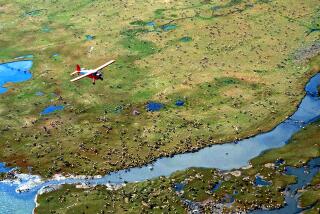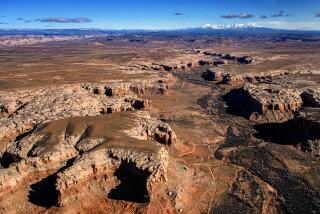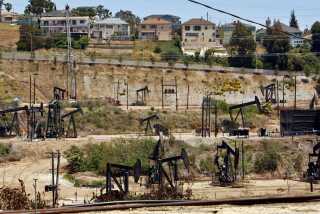Don’t Destroy the Wild Places for Oil
When I was flying combat missions over the devastated landscapes of Korea and Vietnam in the 1950s and ‘60s, I took comfort from the thought that the pristine mountains and forests of my own country awaited my return.
The country I fought for and served was more than just a government, or even a people. In my mind, the idea of the United States of America is inextricably linked with the natural beauty and grandeur of our homeland.
In recent months, citing the wartime urgency of reducing our imports of foreign oil, oil companies and their friends have been calling on Congress to open the Arctic National Wildlife Refuge to oil drilling.
Opening the last 5% of Alaska’s North Slope would do virtually nothing to increase our national security, while inflicting an incalculable injury on one of our last remaining wild places.
The refuge is a uniquely American place of free-flowing rivers, primeval herds of musk oxen, flocks of waterfowl and unclimbed mountains.
The native Gwich’in people call it “The Place Where Life Begins”; the caribou on which they depend gather to give birth there every spring.
Oil companies claim to have made drilling more environmentally friendly, but such claims are relative. You simply can’t drill oil without spilling oil.
The Alaska Department of Environmental Conservation records close to 400 spills each year. This amounts to 1.3 million gallons of oil and other toxic substances over the last five years.
One need only look at the sprawling industrial complex that has cropped up around Alaska’s Prudhoe Bay oil fields, which are a few hundred miles to the west, to understand that oil exploration would irrevocably change the face of the Arctic National Wildlife Refuge.
If the United States is really serious about weaning itself from foreign oil, the smartest, quickest and most economical solution is to use less of it.
That means getting more out of each barrel. If we took advantage of existing and emerging technology to produce cars that travel farther on a gallon of gas, we could dramatically reduce demand and pollutants.
In the process, the American consumer would save money at the pump. In fact, if our passenger vehicles went just three more miles on a gallon of gas, we would save a million barrels of oil a day. That is almost twice as much as we’re importing from Iraq and five times what we might get from the Arctic refuge, according to the Wilderness Society.
We have the technology to make our society more efficient. We have only lacked the political will to make it happen.
As long as we continue our current rates of consumption, a truly safe long-term supply doesn’t exist. Our reserves (in Alaska and elsewhere) constitute only 3% of the world’s known supply, but we continue to account for 25% of global oil demand.
Some drilling proponents claim the refuge could dramatically reduce our oil imports. But according to the U.S. Geological Survey, the most likely amount of economically recoverable oil under the refuge is 3.2 billion barrels--less than what the United States consumes in six months.
The USGS estimates that the amount of oil likely to be recovered from the Arctic refuge would be no more than 0.3% of the world’s oil reserves, and at no time would oil from the refuge satisfy more than 1% or 2% of total American demand. On top of that, it would take a decade or more to get the oil flowing.
Returning from war, my thoughts of home were first of my family, and then turned to the rivers, forests and deserts that define my sense of the American landscape. Never did I feel I had to fear that those beautiful landscapes would not be there for me on my homecoming.
Today, I wonder if our fighting men and women around the world can be so sure that their American wilderness is safe while they are away.
National security means more than protecting our people, our cities and our sovereignty. It also means protecting the wild places that make our nation special.
Drilling the Arctic National Wildlife Refuge when we have better, cheaper, faster and more responsible solutions to our energy dilemma just doesn’t make good sense or good policy.
More to Read
Sign up for The Wild
We’ll help you find the best places to hike, bike and run, as well as the perfect silent spots for meditation and yoga.
You may occasionally receive promotional content from the Los Angeles Times.






